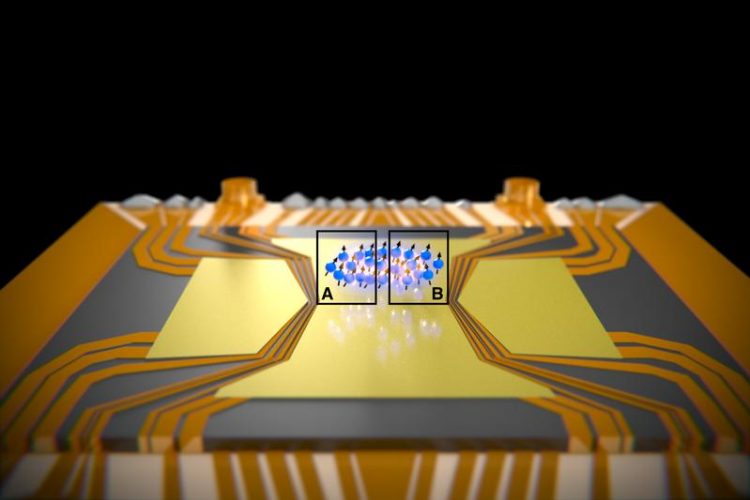Einstein-Podolsky-Rosen paradox observed in many-particle system for the first time

A cloud of atoms is held above a chip by electromagnetic fields. The EPR paradox was observed between the spatially separated regions A and B. Illustration: University of Basel, Department of Physics
How precisely can we predict the results of measurements on a physical system? In the world of tiny particles, which is governed by the laws of quantum physics, there is a fundamental limit to the precision of such predictions. This limit is expressed by the Heisenberg uncertainty relation, which states that it is impossible to simultaneously predict, for example, the measurements of a particle’s position and momentum, or of two components of a spin, with arbitrary precision.
A paradoxical decrease in uncertainty
In 1935, however, Albert Einstein, Boris Podolsky, and Nathan Rosen published a famous paper in which they showed that precise predictions are theoretically possible under certain circumstances. To do so, they considered two systems, A and B, in what is known as an “entangled” state, in which their properties are strongly correlated.
In this case, the results of measurements on system A can be used to predict the results of corresponding measurements on system B with, in principle, arbitrary precision. This is possible even if systems A and B are spatially separated. The paradox is that an observer can use measurements on system A to make more precise statements about system B than an observer who has direct access to system B (but not to A).
First observation in a many-particle system
In the past, experiments have used light or individual atoms to study the EPR paradox, which takes its initials from the scientists who discovered it. Now, a team of physicists led by Professor Philipp Treutlein of the Department of Physics at the University of Basel and the Swiss Nanoscience Institute (SNI) has successfully observed the EPR paradox using a many-particle system of several hundred interacting atoms for the first time.
The experiment used lasers to cool atoms to just a few billionths of a degree above absolute zero. At these temperatures, the atoms behave entirely according to the laws of quantum mechanics and form what is known as a Bose-Einstein condensate – a state of matter that Einstein predicted in another pioneering paper in 1925. In this ultracold cloud, the atoms constantly collide with one another, causing their spins to become entangled.
The researchers then took measurements of the spin in spatially separated regions of the condensate. Thanks to high-resolution imaging, they were able to measure the spin correlations between the separate regions directly and, at the same time, to localize the atoms in precisely defined positions. With their experiment, the researchers succeeded in using measurements in a given region to predict the results for another region.
“The results of the measurements in the two regions were so strongly correlated that they allowed us to demonstrate the EPR paradox,” says PhD student Matteo Fadel, lead author of the study. “It’s fascinating to observe such a fundamental phenomenon of quantum physics in ever larger systems. At the same time, our experiments establish a link between two of Einstein’s most important works.”
On the path towards quantum technology
In addition to their basic research, the scientists are already speculating about possible applications for their discovery. For example, the correlations that are at the heart of the EPR paradox could be used to improve atomic sensors and imaging methods for electromagnetic fields. The development of quantum sensors of this kind is one objective of the National Centre of Competence in Research Quantum Science and Technology (NCCR QSIT), in which the team of researchers is actively involved.
Original source
Matteo Fadel, Tilman Zibold, Boris Décamps, and Philipp Treutlein
Spatial entanglement patterns and Einstein-Podolsky-Rosen steering in Bose-Einstein condensates
Science (2018), doi: 10.1126/science.aao1850
Further information
Prof. Dr. Philipp Treutlein, University of Basel, Department of Physics, phone: +41 61 207 37 66, email: philipp.treutlein@unibas.ch
Media Contact
More Information:
http://www.unibas.chAll latest news from the category: Physics and Astronomy
This area deals with the fundamental laws and building blocks of nature and how they interact, the properties and the behavior of matter, and research into space and time and their structures.
innovations-report provides in-depth reports and articles on subjects such as astrophysics, laser technologies, nuclear, quantum, particle and solid-state physics, nanotechnologies, planetary research and findings (Mars, Venus) and developments related to the Hubble Telescope.
Newest articles

Superradiant atoms could push the boundaries of how precisely time can be measured
Superradiant atoms can help us measure time more precisely than ever. In a new study, researchers from the University of Copenhagen present a new method for measuring the time interval,…

Ion thermoelectric conversion devices for near room temperature
The electrode sheet of the thermoelectric device consists of ionic hydrogel, which is sandwiched between the electrodes to form, and the Prussian blue on the electrode undergoes a redox reaction…

Zap Energy achieves 37-million-degree temperatures in a compact device
New publication reports record electron temperatures for a small-scale, sheared-flow-stabilized Z-pinch fusion device. In the nine decades since humans first produced fusion reactions, only a few fusion technologies have demonstrated…





















